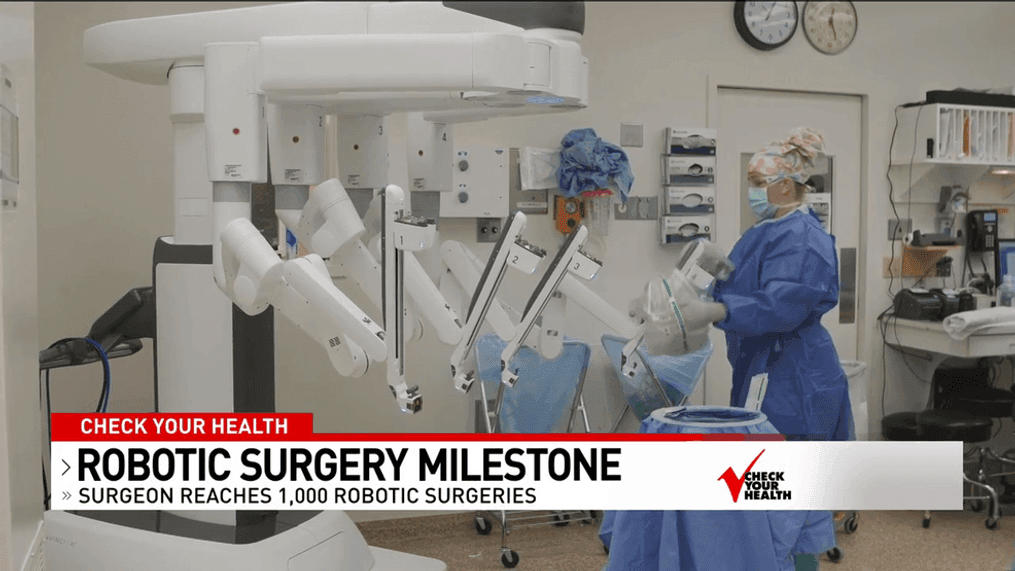Check Your Health- Surgeon Reaches Remarkable 1,000 Robotic Surgery Milestone

Intermountain Health has become a national leader for advances in robotic surgeries with Intermountain surgeons performing thousands of surgical procedures using robot-assisted devices for a variety of surgical procedures for patients across the state.
In fact at least six Intermountain surgeons have reached a remarkable milestone: 1,000 robotic surgeries performed to date.
Richard Matern, MD, is a urologic surgeon for Intermountain Health and regional lead for robotic medicine, who is the latest Intermountain surgeon to complete 1,000 robotic surgeries.
Dr. Matern trained at Tulane University in New Orleans, specializing in urology. He says he’s seen a lot of change since that first surgery in the operating room.
“During training, robotic surgeries could take up to eight hours,” said Dr. Matern. “But the tools continue to improve, and the minimally invasive surgeries allows us to get patients back on their feet and even send some home that same day.”
“1,000 robotic surgeries equate to about 57 straight days of time behind the robotic console controlling the robots,” noted Dr. Matern. “However, it really takes the entire surgical team at Intermountain Health to success reach this milestone. It’s landmarks like this that have revolutionized complex surgical procedures for our patients.”
Robotic-assisted laparoscopic surgery is a minimally invasive surgery that allows surgeons to operate in less accessible areas of the body with a magnified view of the surgical field, providing maximum dexterity for the surgeon.
Although robotic surgeries are not new, Intermountain Health has recently launched the da Vinci XI- robotic assisted surgical system in many of its community hospitals, including Intermountain Cassia Regional Hospital in Burley, Idaho, where surgeons are using the robot for bariatric surgery, laparoscopic surgery, hernia repairs, appendectomies, and gall bladder surgery.
Intermountain Health has also added the Mako SmartRobotics system at Intermountain Park City Hospital and Intermountain Spanish Fork Hospital. The Mako robotic system is designed to assist orthopedic surgeons who perform partial and full knee replacements.
The Mako robotic system also features haptic technology, which provides auditory, tactile, and visual feedback to help surgeons stay within the planned boundaries during implant placement and bone preparation.
“Total knee surgery is really a soft tissue balancing operation and the robot lets us be very precise with the cuts we need to make so that we do fewer ligament releases which leads to quicker recovery with less pain,” said Blake Gillette, MD, orthopedic surgeon at Intermountain Spanish Fork Hospital.
Intermountain LDS Hospital in Salt Lake City and Intermountain Medical Center in Murray have also added the Globus Excelsius robot for spine surgery, which is designed to improve accuracy and optimize patient care by using a navigation system, much like the GPS in your car.
At Intermountain Medical Center, cardiac specialists were among the first in the world – and first in Utah – to use the Stereotaxis Genesis robotic system to perform cardiac ablation, a common minimally invasive procedure to treat patients suffering from heart arrhythmias.
In all Intermountain Health is currently offering robotic programs at 20 hospitals across its health system with 46 robots – improving access for surgeons and patients.
Intermountain Health surgeons who have completed 1,000 robotic surgeries include:
- Dr. John Rahab, Intermountain Good Samaritan Hospital, Lafayette, CO.
- Dr. Justin Green, Intermountain Good Samaritan Hospital, Lafayette, CO.
- Dr. Jess Hunn, Intermountain Medical Center, Murray.
- Dr. Steve Grover, Intermountain Utah Valley Hospital, Provo.
- Dr. Ric Rasmussen, Intermountain Utah Valley Hospital, Provo.
The most widely used robot is the da Vinci XI robotic assisted surgical system - which is used for minimally invasive surgical procedures for gynecologic, urologic, thoracic, cardiac, and general surgical patients. Intermountain Health surgeons have performed 65,615 surgeries using the da Vinci surgical system since the first procedure in 2007.
How Does Robotic Surgery Work?
- Though despite the term “robotic,” robots do not perform the surgeries. A surgeon performs the procedures using instruments that are guided via a fiber linked console.
- The surgeon makes small incisions on the patient’s abdominal or chest area for placing ports for the camera and robotic arms. Once the robot is docked, the instruments are guided carefully into the surgical field.
- The surgeon sits at a master console in the operating room. Using real-time magnified HD-3D view of the operative field, the surgeon’s hand movements are precisely replicated by the robotic instruments in the surgical field.
“With the precision-centric approach of robotics, radical procedures can be performed with the preservation of nerves, arteries and other critical structures without compromising treatment outcomes,” said Dr. Matern.
The robot is also beneficial for the surgeons, as it re-establishes good hand-eye coordination, provides better ergonomics, and makes instrument operation more natural than laparoscopic procedures.
Other kinds of minimally invasive operations have been done for decades, such as laparoscopic surgery to remove a gall bladder, where doctors use small incisions and directly control long-handled instruments and a fiber optic camera.
“However, there’s much greater dexterity with a robotic system than with conventional laparoscopic instruments,” said Dr. Matern. “This makes it possible to do more challenging and complex operations, but still be minimally invasive.”
Go here for more information and options about robotic surgery at Intermountain Health.